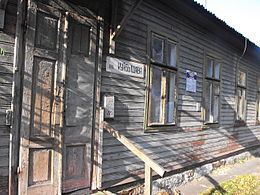Also known as Brześć Litewski Ghetto | Organizations Nazi SS | |
 | ||
Location Brześć, German-occupied Poland Date December 16, 1941 to October 15, 1942 Incident type Imprisonment, starvation, mass shootings | ||
The Brześć Ghetto or the Ghetto in Brest on the Bug, also: Brześć nad Bugiem Ghetto, and Brest-Litovsk Ghetto (Polish: getto w Brześciu nad Bugiem, Yiddish: בריסק or בריסק-ד׳ליטע) was a World War II Jewish ghetto created on December 16, 1941 in occupied Poland, six months after Nazi Germany overrun the Soviet occupation zone, under the codename Operation Barbarossa. Less than a year later, around October 15–18, 1942, most of approximately 20,000 Jewish inhabitants of Brześć were massacred; over 5,000 were executed locally at the Brest Fortress on the orders of Karl Eberhard Schöngarth; the rest in the secluded forest of Bronna Góra (the Bronna Mount, Belarusian: Бронная гара) killing site, sent there aboard Holocaust trains.
Contents
Background
Before World War II, Brześć nad Bugiem (known as Brześć Litewski before the partitions, now Brest, Belarus) was the capital of Polesie Voivodeship in the Second Polish Republic (1918–39) with the most visible Jewish presence. In the twenty years of Poland's sovereignty, of the total of 36 brand new schools established in the city, there were ten public, and five private Jewish schools inaugurated, with Yiddish and Hebrew as the language of instruction. The first ever Jewish school in Brześć history opened in 1920, almost immediately after Poland's return to independence. In 1936 Jews constituted 41.3% of the Brześć population, or 21,518 citizens. Some 80.3% of private enterprises were owned by Jews. Before World War I, Brześć (then known as Brest-Litovsk) was controlled by the Russian Empire for a hundred years following the partitions of Poland, and all commercial activity was largely neglected.
Brest-Litovsk (Brześć Litewski) was renamed as Brześć nad Bugiem (Brest on the Bug) in reborn Poland on March 20, 1923. Just before the outbreak of World War II, there was an anti-Jewish riot at the bazaar in Brześć on May 15, 1939. Some Jewish sources categorize it as Polish although ethnic Belarusians constituted 17.8% of the population, and preached militant nationalism among its youth similar to local Ukrainians and Russians, under systematic indoctrination by Soviet emissaries.
Ghetto history
In September 1939 during the German and Soviet invasion of Poland, the town of Brześć (Brest) was overrun by the German troops and handed over to the Russians during the German–Soviet military parade in Brest-Litovsk on September 22, 1939. The whole province was soon annexed by the Soviet Union following mock elections by the NKVD secret police, conducted among the locals in the atmosphere of fear and terror. The mass deportations of Poles and Jews to Siberia followed.
The German armed forces launched Operation Barbarossa against the Soviet Union – its own wartime ally – on June 22, 1941; and six months later, on December 16, 1941 established a Nazi ghetto in the city for some 18,000 Polish Jews, who still resided there after months of deportations and ad hoc mass executions. On July 10–12, 1941 the German Einsatzgruppe under SS-Obergruppenführer Karl Eberhard Schöngarth massacred 5,000 Jews including 13-year-old boys and 70-year-old men in a single nighttime "anti-partisan" raid. The Orpo battalions passing through Brześć and Białystok carried out significantly larger shooting actions. "The first massacre of Brest Jews – wrote Christopher Browning – was perpetrated not by the notorious Einsatzgruppen but rather by Police Battalion 307 with Wehrmacht support, in mid-July, on the orders of Himmler's chief of Order Police, Kurt Daluege."
In January 1941, first underground resistance organizations were formed by Jews in the ghetto. In the autumn of 1942 the Germans demanded a large payment (money, jewelry) from the Jews under the threat of liquidating the ghetto. Despite payment worth 26 million rubles, the ghetto was liquidated soon afterwards. The Jews were rounded up for "relocation", and murdered over execution pits north-east of the city at the Bronna Mount (Bronna Góra) forest, the more distant place of secluded massacres of some 50,000 Jews delivered by Holocaust trains from a number of ghettos including the large Pińsk Ghetto as well.
Holocaust rescue
Father Mieczysław Akrejć, a Catholic priest from Brześć, contributed 4,000 gold rubles to help the Judenrat pay the huge ransom to the Germans, nevertheless the ghetto was liquidated a few days later. Father Jan Urbanowicz, Dean of the Holy Cross Parish in Brześć, was executed by the Germans in June 1943 for issuing false baptismal certificates as Christians for the Polish Jews. Polish priests were murdered in several neighbouring towns. The Reverend Władysław Grobelny from Kobryń near Brześć was executed on October 15, 1942 together with the Jews he was helping. The priests were apprehended when the false certificates of murdered Jews were examined by the SS with the aid of the Ukrainian Auxiliary Police.
The Jewish family of Tiders expelled from Zaborowo in 1940 were murdered in Brześć with children except for their oldest son, 24-year-old Mendel Tider, who paved the road to Tamowo on German orders at the time of the killings. He escaped to Bochnia where he met Józef Langdorf from his neighbourhood. Together, they escaped back to Zaborowo and found refuge at the farm of the Mika family of six. Both survived, treated like relatives and fed for free until liberation. In 2000 the three members of the Mika family were bestowed the titles of the Righteous thanks to Mrs Langdorf from Israel. Stefan Mika was 73, and living in Kraków; the other two, father and mother, were already dead for several decades. Dr. Zelikson from Brześć escaped to Warsaw where he hid with 8 other Jews at the Maria and Jan Langiewicz's school, on the Aryan side of the city. One of the rescued by Professor Langiewicz testified in 1966: "We, whom he aided and whose spirits he kept up, have built him a living monument in our hearts."
